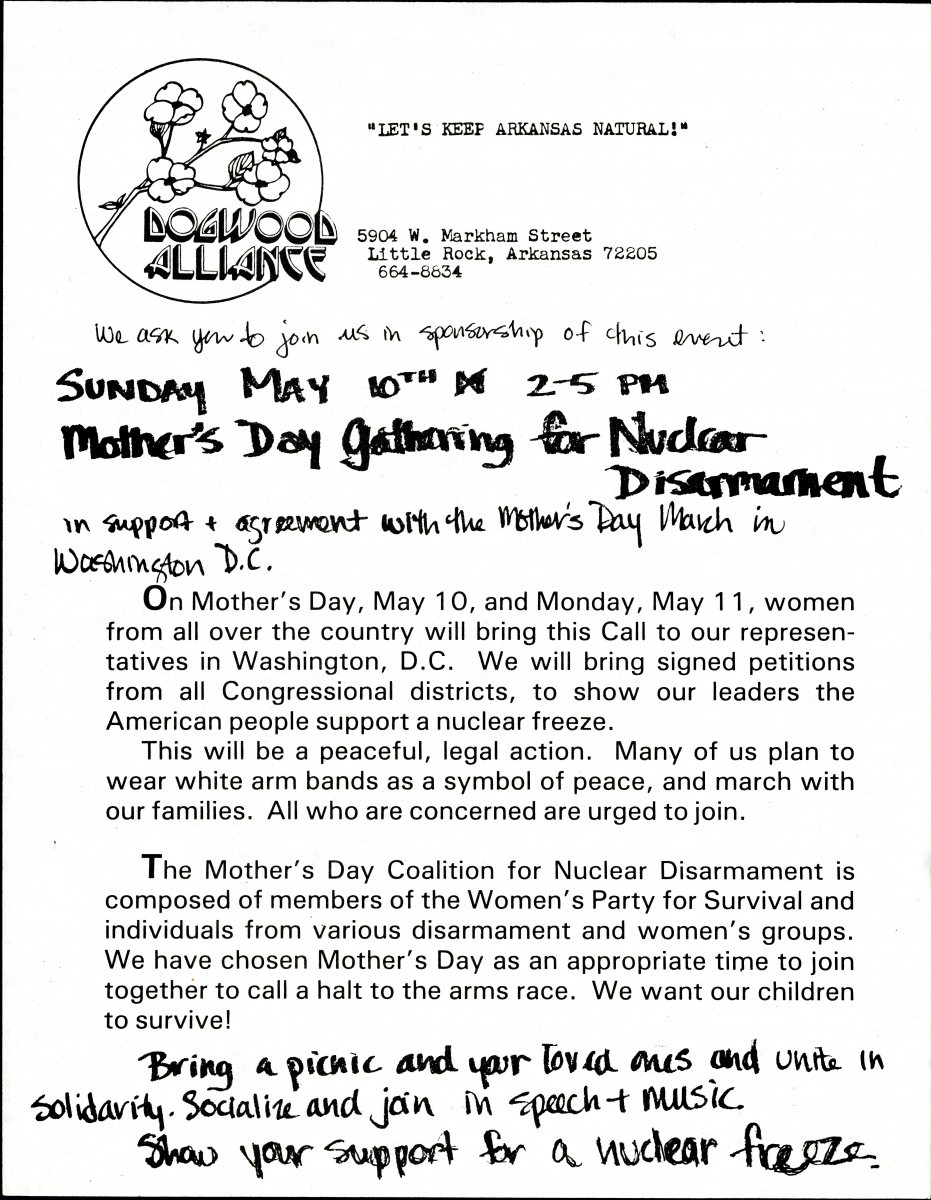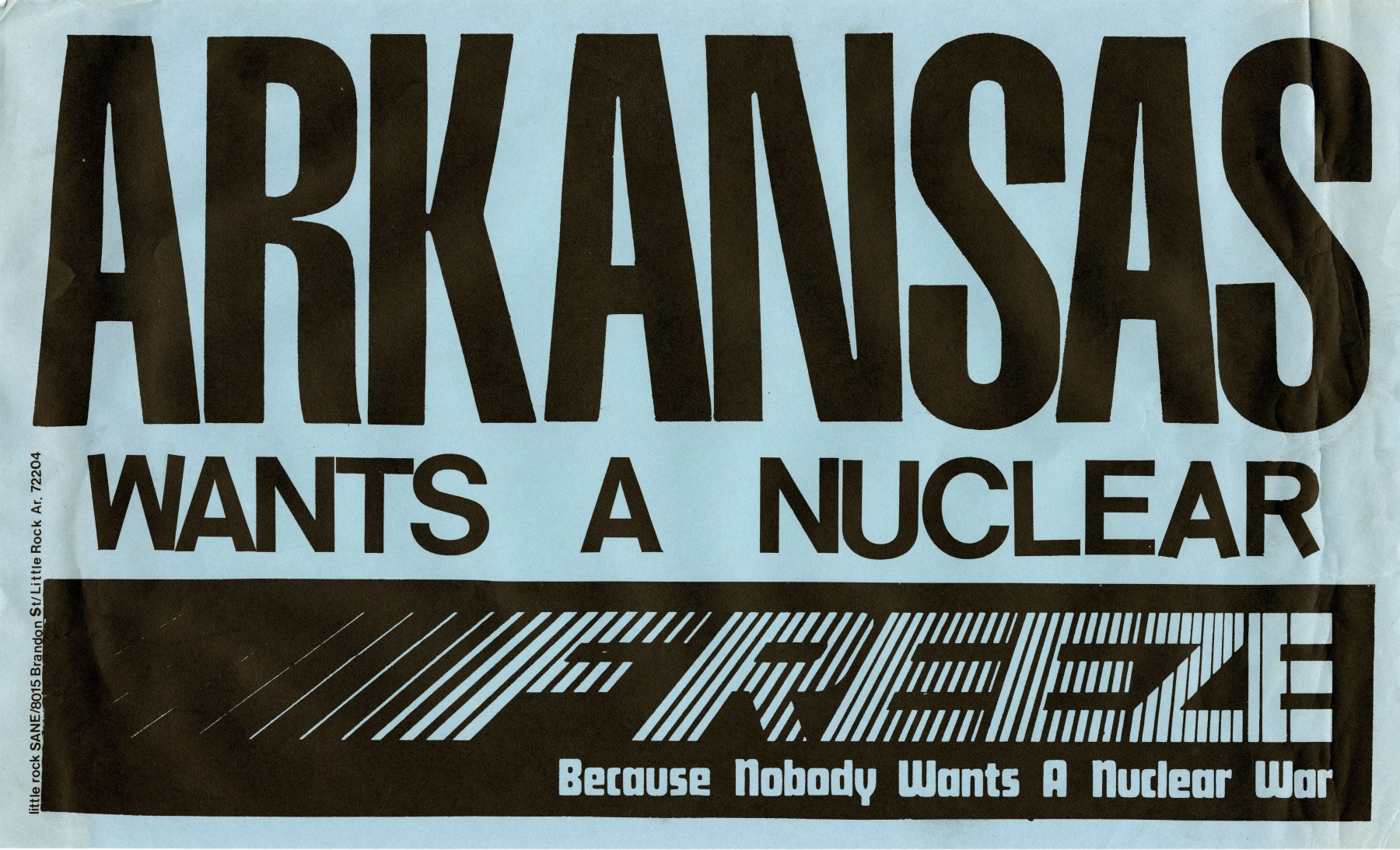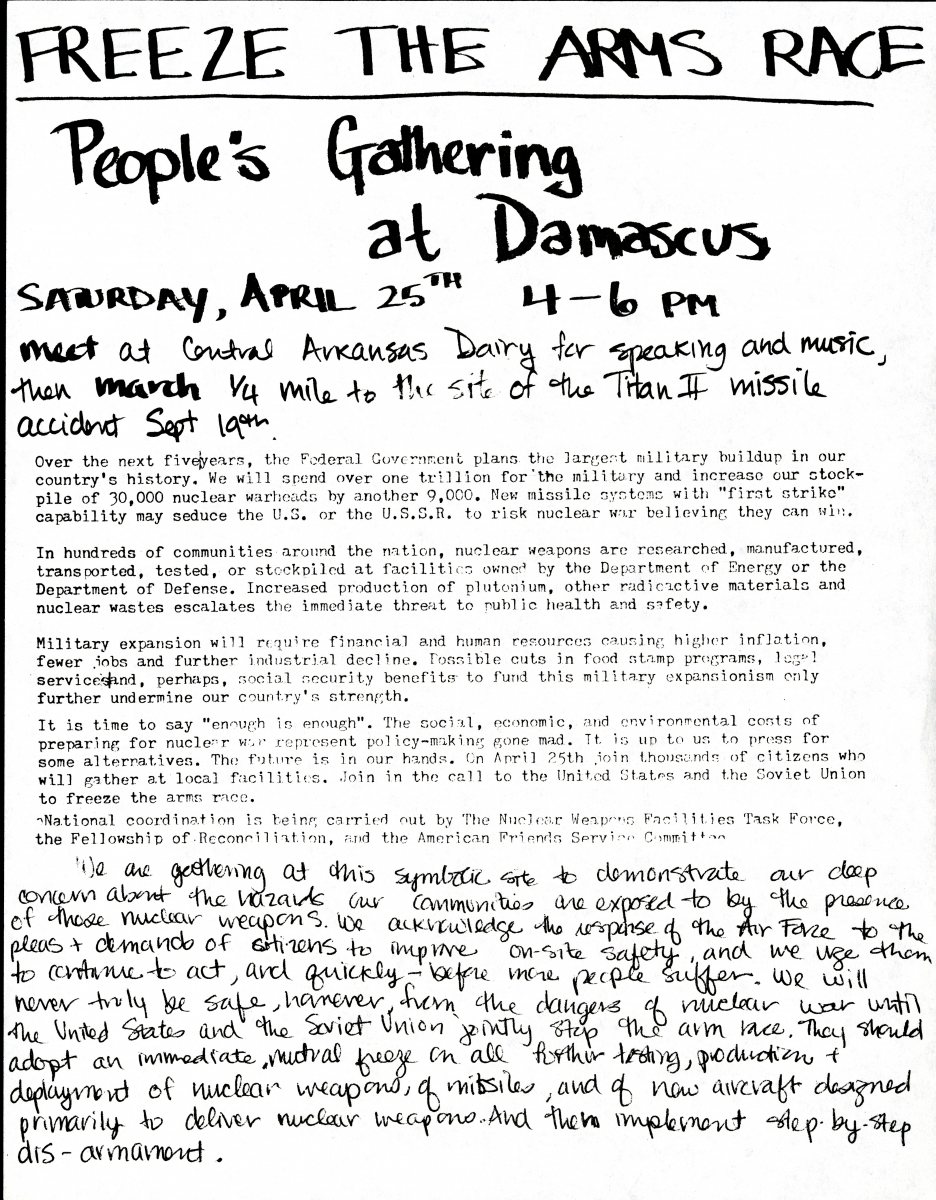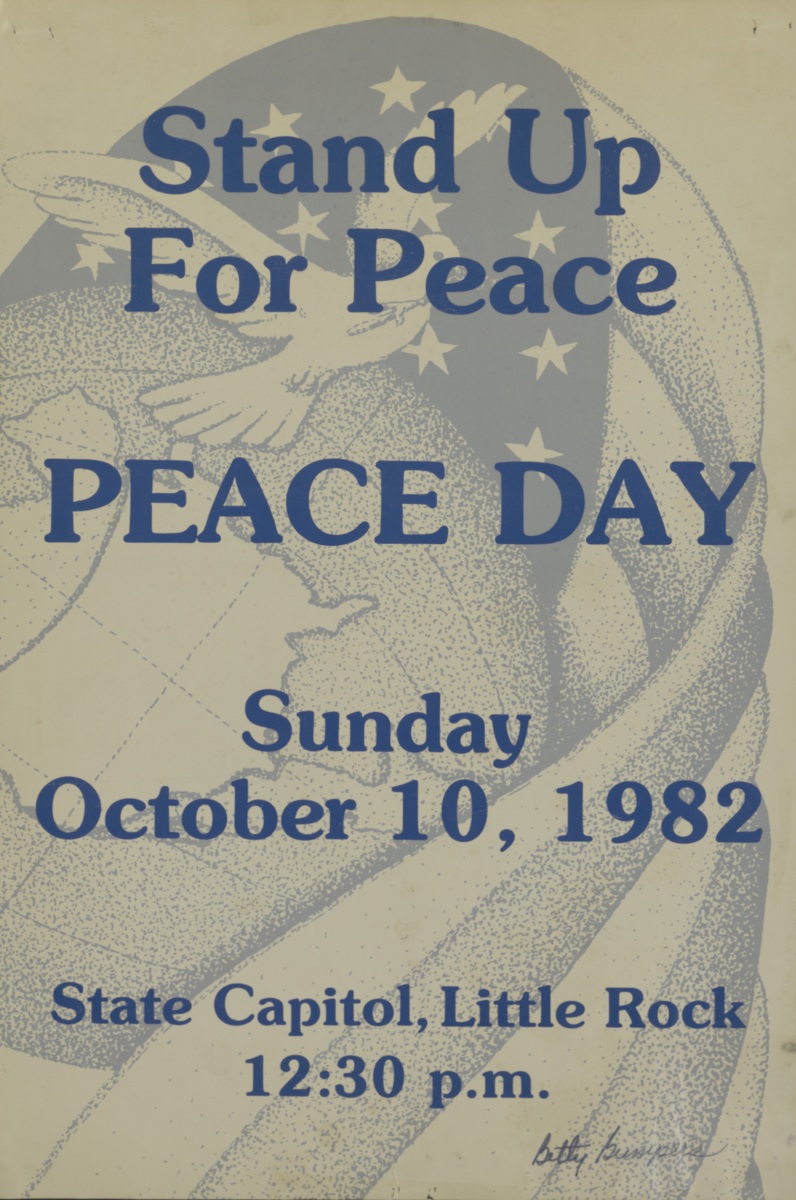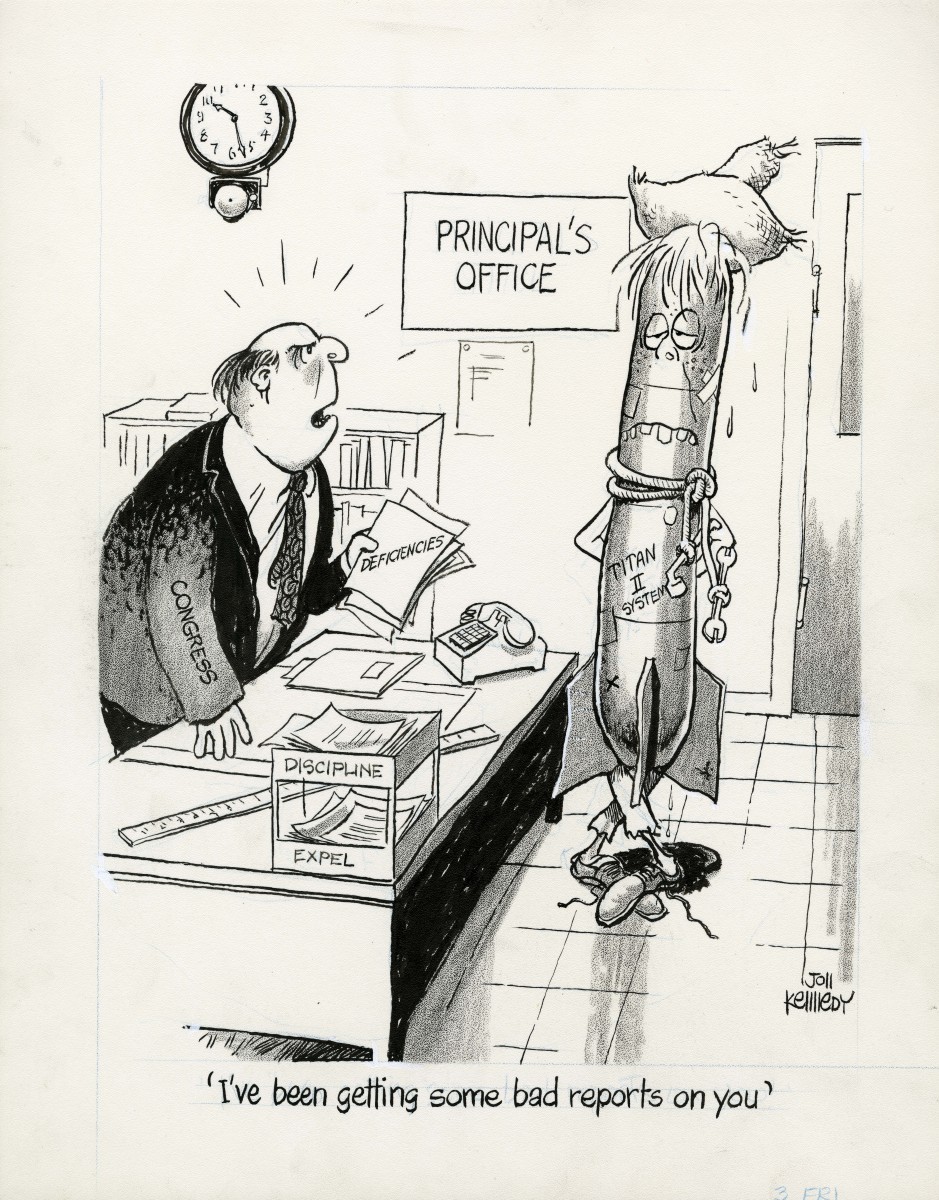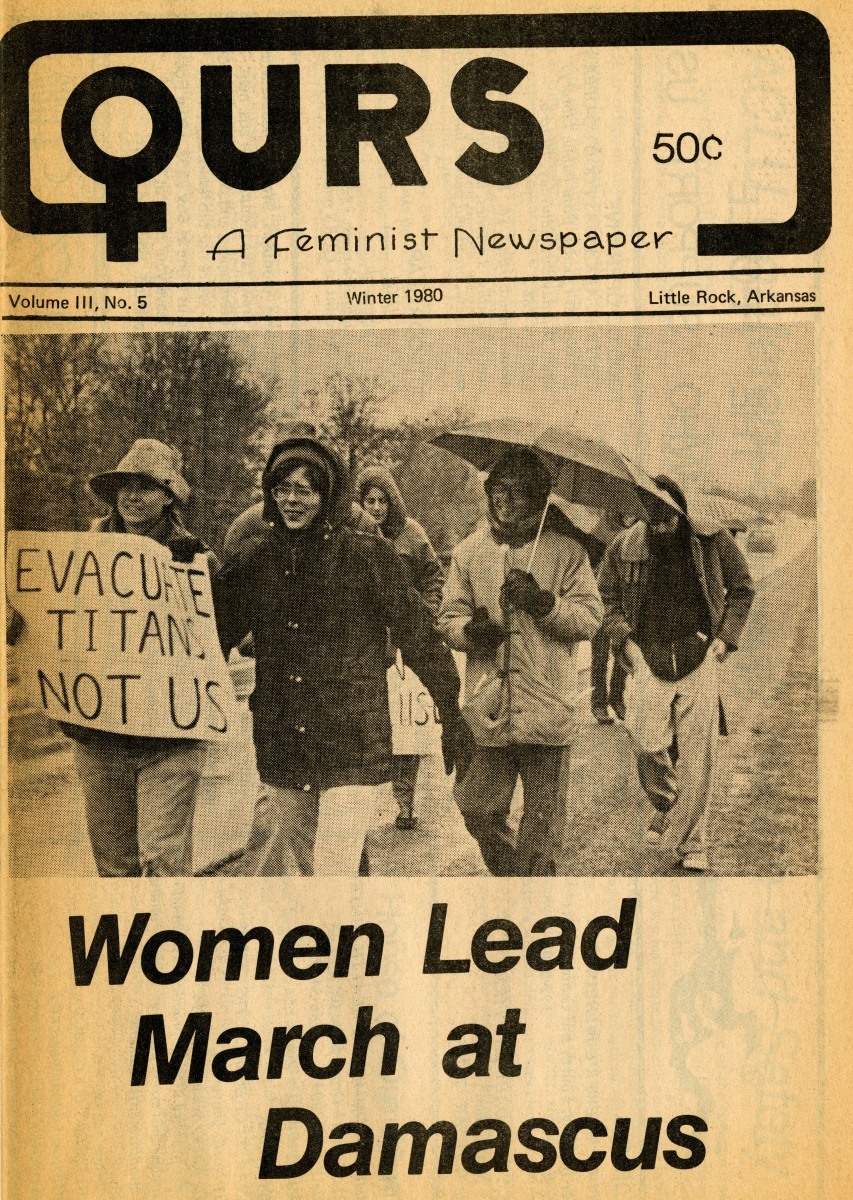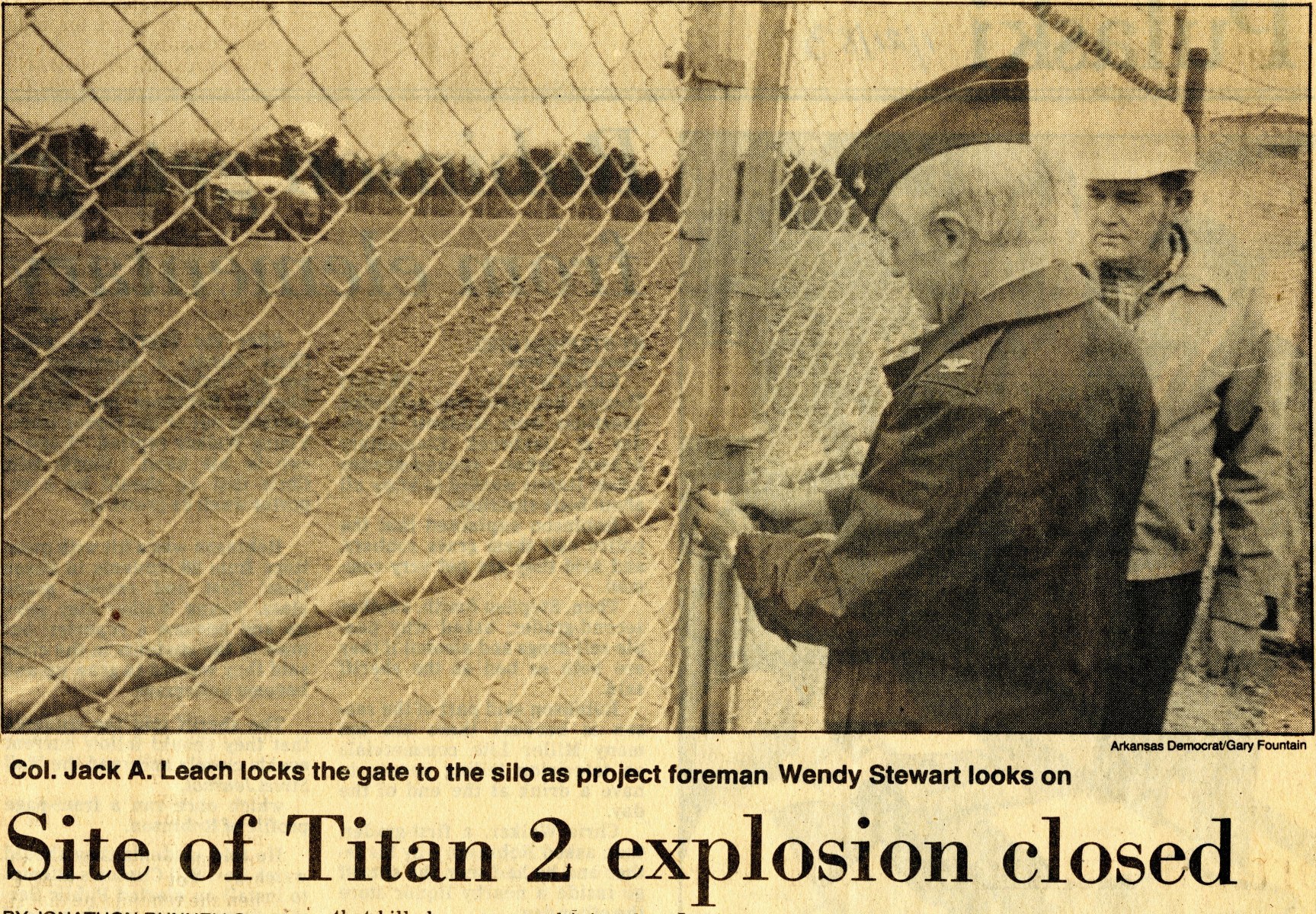Countdown to Disaster
The Titan II Explosion
Imagine waking up one morning to learn that the state of Arkansas was almost destroyed by a nuclear explosion while you slept...
This might sound like an exaggeration, but on September 18, 1980, a missile hidden underground in the Ozarks sprung a leak in one of its fuel tanks. Hours later, the missile exploded, destroying the silo and command complex and sending twisted metal and a fireball thousands of feet in the air.
You may be asking yourself: What was a nuclear missile doing in Arkansas? What led to the explosion and why did the nuclear warhead fail to activate? How did the government respond? Journey on for the answers to all of your burning questions.
3...the Cold War
The story begins with the onset of the Cold War in the 1940s. As World War II was ending, leaders of the Soviet Union (now Russia) were afraid that the United States would use the atomic bomb that they unleashed on Japanese cities to wipe out the Soviet Union.
Conflict and paranoia quickly grew between the two countries, and each began researching ways to build more deadly weapons. Both countries stockpiled nuclear bombs during what is commonly known as the “arms race.” They also competed to be the first to send people into space because of the military advantages that could be gained by installing surveillance cameras and weapons high above the Earth.
In 1949, the Soviet Union exploded its first atomic bomb. The United States government then put hundreds of engineers to work building a new weapon, the intercontinental ballistic missile (ICBM), which could be launched from U.S. soil and hit targets across the world. To shelter the ICBMs and be sure they were ready to launch at the push of a button, hundreds of underground launch complexes were secretly built across the United States during the Cold War.
The complexes were grouped together in missile fields. Arkansas was home to 18 Titan II ICBMs in a missile field located north of Conway. The Damascus missile complex was at the Southside location, indicated by the red star on the map above. The Air Force also chose two other states to site Titan II missiles: Arizona and Kansas.
Below is a picture of a Titan II underground launch complex. Click on the different structures to learn what they are.
2...the Missile
The Titan II was the biggest and heaviest ICBM ever built in the United States. The missile measured over 100 feet long with a diameter of 10 feet and had a mass of 135 tons. It could travel as far as 9,321 miles or 15,000 kilometers. To learn more about the Titan II missile, click on the pink icons in the missile picture on the right.
How far is 15,000 kilometers? Click on the photograph below to launch a virtual tour to find out. (The window will open in a new tab)
With the Titan II, the United States had the power to destroy almost any country in the world and kill millions of people. The Titan II was designed to deliver nine megatons of damage. Engineers who worked on the Titan II said that although they knew they were creating a death machine, they did not fully consider the threat to people in the United States living near the missile silos.
To learn more about the Titan II missile, click on the photograph to the right to explore the Titan Missile Museum.
Arkansas quickly learned the dangers of the missile complexes after construction began in 1961. In 1965, a fire broke out in a Titan II silo near Searcy, Arkansas, during an upgrade and maintenance project. Fifty-three workers lost their lives in the deadliest accident ever to occur in a U.S. nuclear weapons facility. News of this disaster made national headlines. The missile in the silo that day was eventually moved to another launch complex near Damascus.
1...the Resistance
Tragedies like the Searcy accident led to a growing anti-nuclear peace movement. Activists called for disarmament and a freeze on all other uses of nuclear reaction.
If you’ve ever been to Russellville and seen the giant nuclear energy reactor on the horizon, you know that nuclear power is also used to generate electricity. The first unit at the Arkansas Nuclear One power plant began operations in Russellville in 1974. In the years that followed, anti-nuclear protest actions were regularly planned by a variety of groups including the Dogwood Alliance.
Women led the anti-nuclear movement. Many of the women marching and advocating for an end to nuclear arms were also active in campaigns to convince the Arkansas legislature to ratify the Equal Rights Amendment to the U.S. Constitution, which would have given legal rights to women. They argued that nuclear disarmament was a women’s issue by drawing a connection between gender-based violence and war. Women are often front-row witnesses to the danger and damage of nuclear weapons on their children and communities. Like the women's movement, the peace movement centered the protection of human dignity, which they believed could be achieved by ending violence at all levels of society. Some of the peace organizations founded by women in the 1980s are still active in Arkansas today, though their focus has changed since the end of the Cold War.
In 1979, one year before the missile explosion in the Ozarks, peace activists’ worst nightmare came true. A reactor at a nuclear power plant on Three Mile Island in Pennsylvania had a partial nuclear meltdown and leaked radioactive material into the surrounding communities. State officials, fearful of a possible hydrogen explosion, encouraged residents to evacuate the area as the disaster unfolded. Engineers were able to prevent any explosions and most residents returned to the area within a few months. The Three Mile Island crisis led to more federal regulations and safety measures to prevent similar events in the nuclear power industry.
Meanwhile, President Jimmy Carter and Secretary of State Cyrus Vance regularly traveled overseas for negotiations with the Soviet Union known as the Strategic Arms Limitation Talks or SALT II. Just months after the Three Mile Island meltdown in 1979, President Carter and General Secretary Leonid Brezhnev signed an agreement to limit missile production on both sides.
Arkansas leaders were very interested in the results of the SALT II negotiations. The eighteen Titan II missiles on alert in the Ozarks made Arkansas a potential target in a Soviet attack. In the following clip, Arkansas Congressman (and eventual Governor) Jim Guy Tucker interviews U.S. Secretary of State Cyrus Vance in 1977 about his recent trip to the Soviet Union for continued negotiations.
Even though the leaders of the United States and the Soviet Union signed the SALT II treaty, the United States Congress refused to approve the agreement after the Soviet Union invaded Afghanistan in 1979. At that point, all talks were off the table.
0...the Explosion
By 1980, the Titan II missiles were nearing 20 years old. Several U.S. Airmen assigned to staff the command centers at each missile complex and maintain the weapons were worried about safety as the missiles aged. An anonymous group of Airmen met with non-military officials in 1980 to ask for help. They felt their lives were in danger and that the U.S. Air Force was not taking the issue seriously. Unfortunately, death and destruction would unfold before Arkansas leaders could get involved.
On the evening of September 18, 1980, a routine maintenance operation went very, very wrong. After arriving on site and making their way through the underground complex to the missile silo, the maintenance team got to work on several routine repairs around 6:30 p.m. Two airmen worked high up on platforms that extended from the silo’s walls. All of a sudden, one of the men dropped a wrench socket, which fell several stories before bouncing and gashing a hole in the side of the missile. Toxic gas immediately began pouring out into the silo. Realizing that the dropped socket had pierced a fuel tank, the terrified airmen retreated. The Air Force assembled an emergency team and evacuated the personnel inside the silo around 9:00 p.m.
At 10:00 p.m. concern grew, and nearby residents asleep in their homes were evacuated from the area.
Two men at a time from the emergency team were sent down into the launch silo to gather readings and attempt to open the silo’s inner blast doors. Just before 3:00 a.m. on September 19, 1980, Senior Airman David Livingston and Sergeant Jeff K. Kennedy put on protective gear and entered the silo. Just as they emerged, the missile exploded, throwing both men and fiery debris hundreds of feet in the air. Livingston died later that day. Kennedy miraculously survived, but was plagued for the rest of his life with medical issues resulting from his injuries.
The explosion injured twenty-one people in total. The nuclear warhead on top of the missile was blown off of the missile body and thrown into the darkness along with other debris. Luckily, it did not explode that day. If it had exploded, people as far away as Georgia would have been affected by the nuclear fallout and thousands of Arkansans would have been killed.
To learn more about what would have happened if the warhead had exploded, click through the slideshow below.
Tens of thousands of Arkansans woke up the next morning unaware that a nuclear warhead detonation had been narrowly averted.
Fear and mystery surrounded the missing warhead as search parties frantically combed the area into the morning hours. The Air Force would not even give a straight answer about the nuclear warhead to Vice President Walter Mondale. Several days later, searchers eventually found the warhead intact in a ditch. Why had it failed to detonate? Military leaders explained that a safety switch had to be turned off at the command center in order for the warhead to activate. Because the explosion in the silo was unintentional, the safety switch was never flipped. On the other hand, a safety engineer who worked on the Titan II believed the one safety switch could have been easily overpowered by extreme heat or other unpredictable conditions. Arkansas was very lucky that day. The Air Force quickly transported the warhead to a missile factory in Texas for closer inspection.
Protests picked up the following month, with hundreds driving in from all over the state to rally and demonstrate for peace.
I was a spokesperson for the Dogwood Alliance, a non-nuclear group active at the time. We organized a trip to the site a couple of weeks later... We rounded the corner to the entrance and saw the crater. It was huge. We all fell silent immediately. -Mark formerly from North Little Rock
In the weeks leading up to the 1980 Presidential election, nuclear disarmament was hotly debated. Ronald Reagan won the election with a plan to increase defense spending and build missiles even faster. The anti-nuclear peace movement grew in response, but nuclear missiles and power plants remain a major part of the American landscape today.
Concerns about the aging Titan II missiles were too big to ignore and President Ronald Reagan announced plans to end the Titan II program in September of 1981, one year after the Damascus explosion. The launch complexes were demolished and filled in. Unless you knew the exact location of one of the Titan II missile sites, they are nearly impossible to find today.

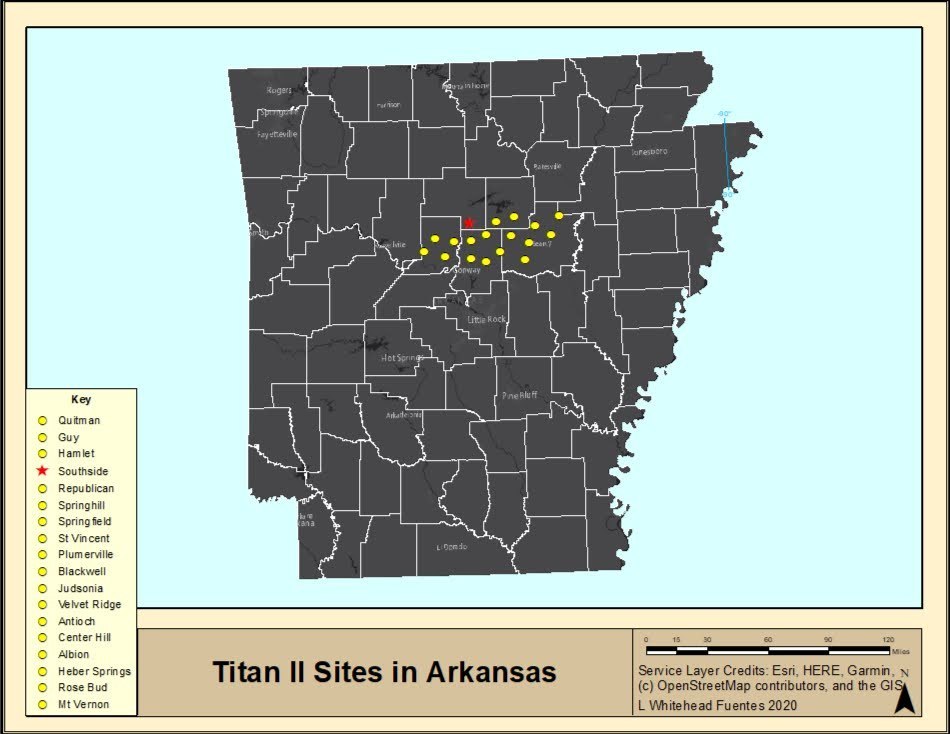
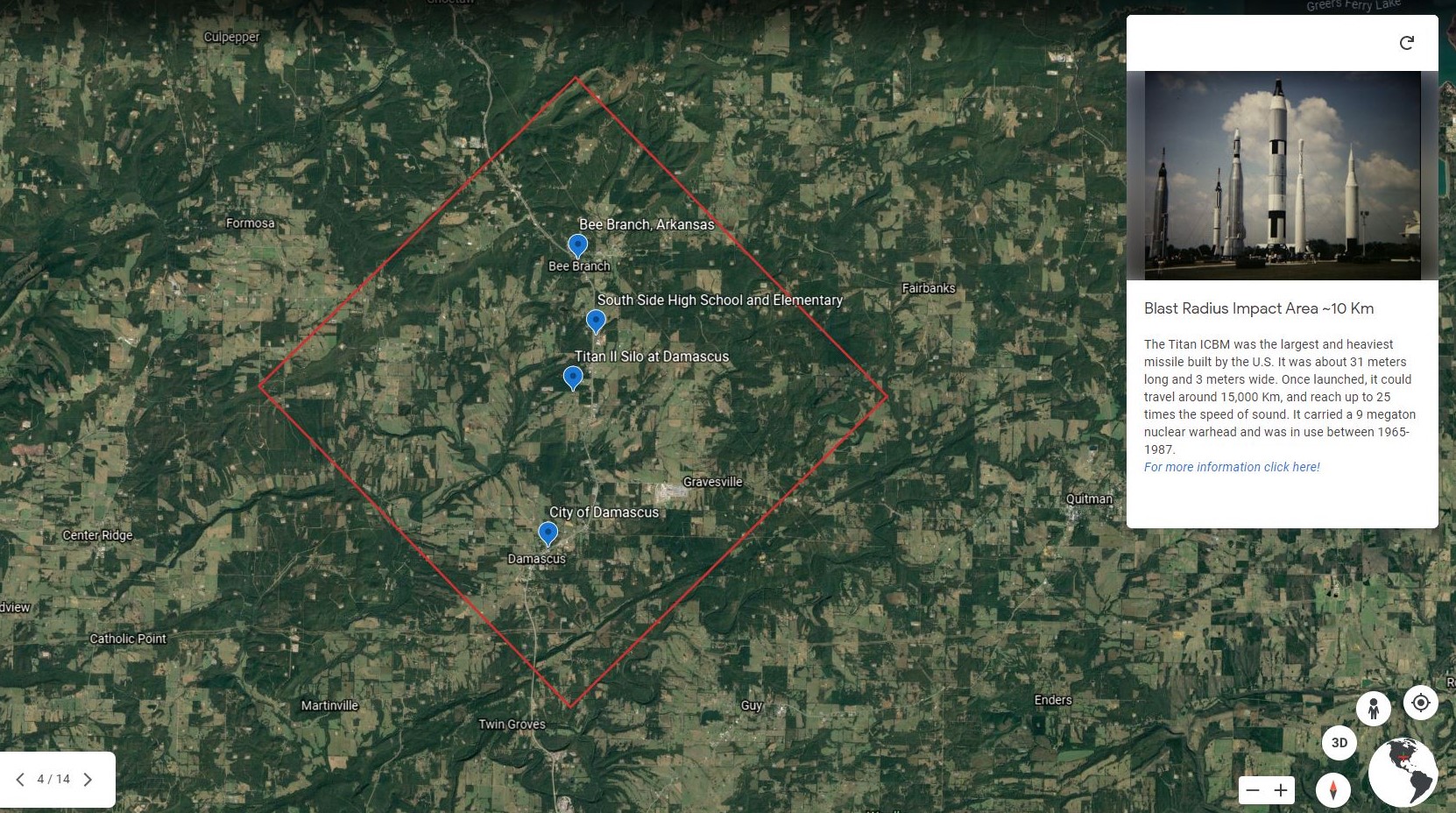
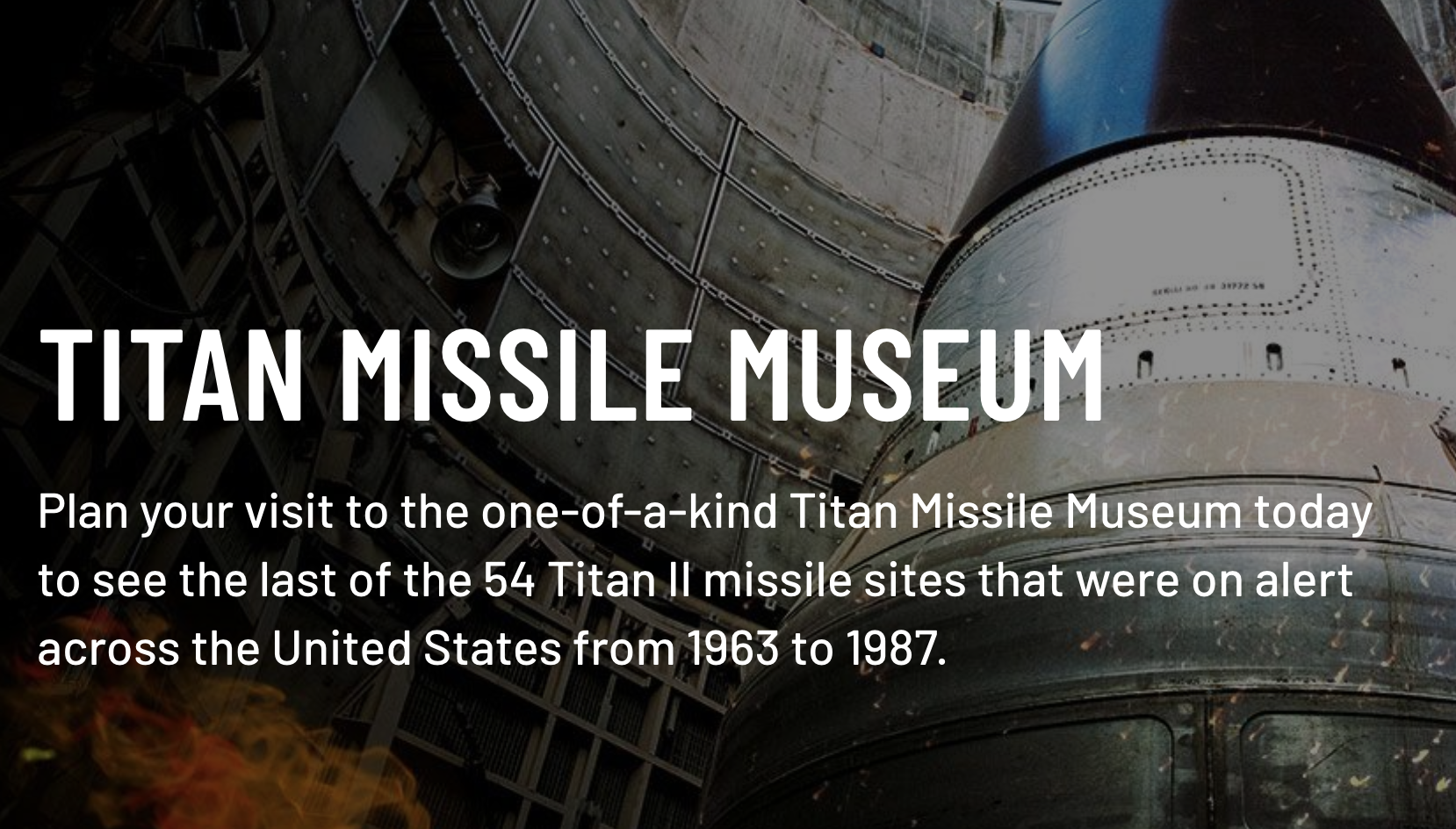
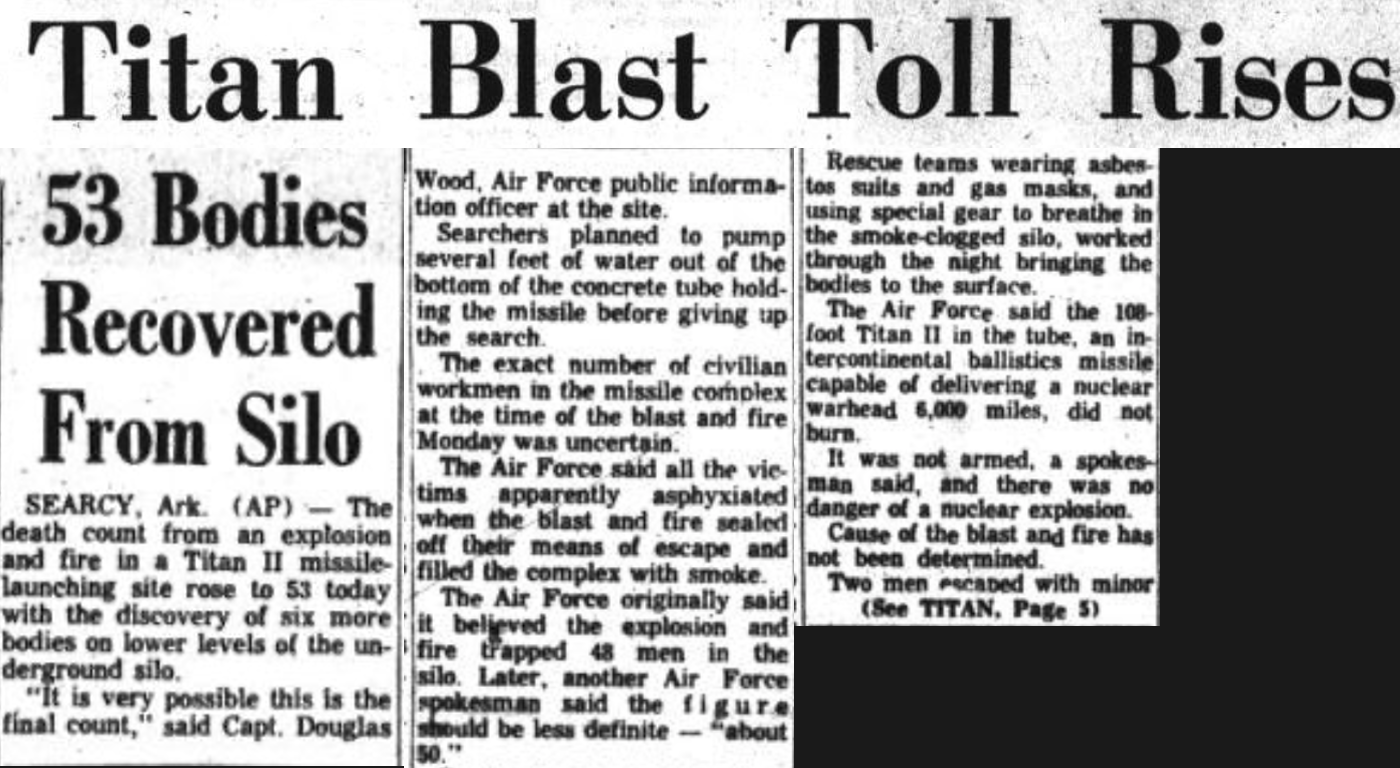
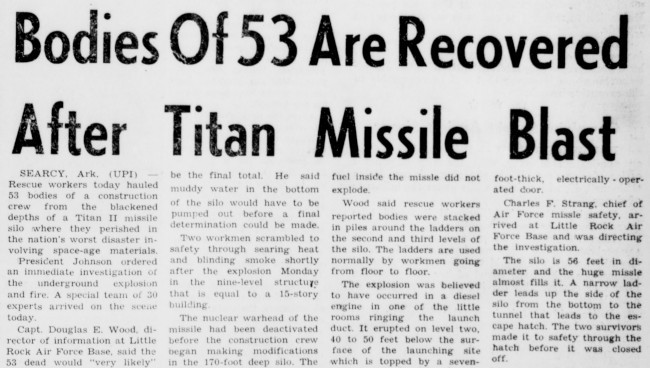
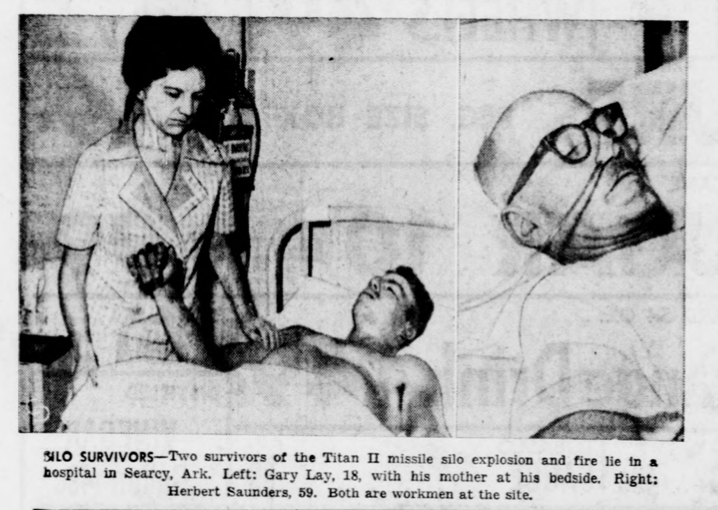

![Physics 'Crying For' Christ Science! "Missile Silo: What Set Off Blast That Suffocated 53?" 'Silo Blast Cause??' [Satan Covers Up Satan!] Physics 'Crying For' Christ Science! "Missile Silo: What Set Off Blast That Suffocated 53?" 'Silo Blast Cause??' [Satan Covers Up Satan!]](https://ualrexhibits.org/zerohour/wp-content/uploads/sites/26/nggallery/titan-ii-newspaper-articles/Screen-Shot-2020-12-15-at-11.18.49-AM.png)
